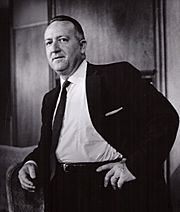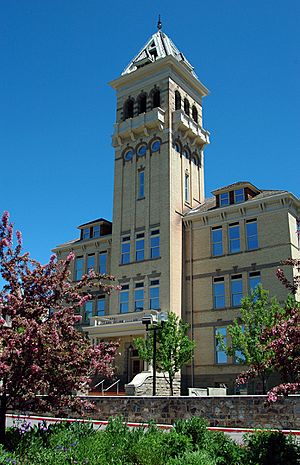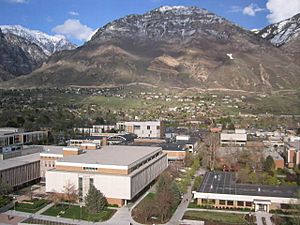Leonard J. Arrington facts for kids
Quick facts for kids Leonard J. Arrington |
|
|---|---|
 |
|
| Church Historian | |
| January 1972 – February 1982 | |
| Predecessor | Howard W. Hunter |
| Personal details | |
| Born | Leonard James Arrington July 2, 1917 Twin Falls, Idaho, U.S. |
| Died | February 11, 1999 (aged 81) Salt Lake City, Utah, U.S. |
| Cause of death | Heart failure |
| Resting place | Logan City Cemetery |
| Known For | LDS Church Historian, 1972–1982 Writings in Mormon history |
| Education | Ph.D (Economics) |
| Alma mater | University of Idaho University of North Carolina at Chapel Hill |
| Occupation | Historian Author University professor |
| Employer | Utah State University Brigham Young University |
| Spouse(s) | Grace Fort (1942–1982) Harriett Ann Horne (1983–1999) |
| Children | 3 |
| Parents | Noah and Edna Arrington |
"As a result of yesterday’s meeting with the First Presidency I have been thinking and praying about my calling as Church Historian. This was also prompted by the necessity of writing an article appraising President Joseph Fielding Smith as a historian. On the one hand, I am the Church Historian and must seek to build testimonies, spread the word, build the Kingdom. On the other hand, I am called to be a historian, which means that I must earn the respect of professional historians—what I write must be craftsmanlike, credible, and of good quality. This means that I stand on two legs—the leg of faith and the leg of reason."
— Leonard J. Arrington (diary, August 1972)
Leonard James Arrington (July 2, 1917 – February 11, 1999) was an American writer, professor, and the person who started the Mormon History Association. He is often called the "Dean of Mormon History" because he made so many important contributions to understanding the history of The Church of Jesus Christ of Latter-day Saints (LDS Church).
From 1972 to 1982, he was the first person outside of the top church leaders to be the official Church Historian for the LDS Church since 1842. He also led the Joseph Fielding Smith Institute for Church History from 1982 to 1986.
Arrington grew up in a big family in Idaho and was a member of the LDS Church. He studied economics at the University of Idaho and the University of North Carolina at Chapel Hill. While teaching at Utah State University in Logan, Utah, he published his famous book, Great Basin Kingdom: An Economic History of the Latter-day Saints, 1830–1900, in 1958. After teaching in Italy, Arrington helped raise money for research on Mormon history. He also taught Western American History at Brigham Young University (BYU) from 1972 to 1987.
| Top - 0-9 A B C D E F G H I J K L M N O P Q R S T U V W X Y Z |
Growing Up in Idaho
Leonard Arrington was born in Twin Falls, Idaho on July 2, 1917. He was the third of eleven children. His parents, Noah and Edna, were farmers and faithful members of the Latter-day Saints.
As a child, Arrington wanted to be a farmer. He was also an active member of the National FFA Organization (Future Farmers of America). For a project, he raised hundreds of chickens and won a prize at the Idaho State Fair in 1934. This project helped him win a scholarship for college.
Arrington was also a Boy Scout. He loved to read books, especially those by naturalist Ernest Thompson Seton. In the summers, he would sleep outside in his family's fruit orchard. This was his quiet place to read and enjoy nature. He felt a special connection to the world around him. This helped him connect his personal feelings about faith with the church's teachings.
During the Great Depression, Arrington became curious about how prices worked. He did his first economic experiment with potatoes. He put notes in sacks of potatoes his family sold, asking people to tell him how much they paid. He found that some people paid much more for the same potatoes than his family sold them for. This showed him how prices could change a lot.
Learning and Studying
Arrington's father offered to pay for him to serve as an LDS missionary. However, he did not offer to pay for university. Arrington chose to go to college, seeing his studies as a way to serve the church.
He received a scholarship to the University of Idaho in 1935. He first studied agricultural science, then changed to agricultural economics. One of his professors taught him that Christianity and science could work together. Another professor helped him see economics as more than just numbers. He learned that economics was about how people relate to each other.
Arrington graduated with high honors in 1939. He then started graduate school at the University of North Carolina at Chapel Hill. In 1942, he married Grace Fort, who later joined the LDS Church in 1946.
During World War II, Arrington served in the Army from 1942 to 1945 in North Africa and Italy. He worked with prisoners of war and for Italy's statistics office. While in North Africa, he felt that God wanted him to become a teacher and writer about religion and economics.
A Career in Academia
After the war, Arrington became a professor at Utah State Agricultural College (now Utah State University) in Logan, Utah. He taught there from 1946 to 1972. He earned his PhD in economics in 1952.
In 1958, Harvard University Press published his book, Great Basin Kingdom: An Economic History of the Latter-day Saints, 1830–1900. This book was based on his doctoral research. It was published with help from a grant, so Arrington did not receive money from it until it was reprinted much later.
Arrington did a lot of his research for Great Basin Kingdom in the LDS Church library archives. He was careful because the archives were not always open to academic research back then. He found ways to get his notes approved and copied.
In Great Basin Kingdom, Arrington showed how early Mormon pioneers used central planning and cooperation. They worked together to build farms in the desert, especially with irrigation. He explained that their way of sharing water reflected their community values. Even though their cooperative economy changed later, their spirit of working together was ahead of its time. The book was seen as a very important work in Mormon history.
From 1958 to 1959, he was a professor in Italy. After returning, Arrington helped raise money to fund the writing of Mormon biographies. Many of these were researched by students and assistants, but published under Arrington's name.
In 1959, Arrington wrote an article for the first issue of BYU Studies. It discussed how Brigham Young encouraged members to follow the Word of Wisdom (a health code) to keep money within Utah. This article was seen as a bit controversial at the time.
From 1972 to 1987, he was a professor at BYU. He received honorary degrees from the University of Idaho in 1977 and Utah State University in 1982.
Starting History Groups
Arrington helped create the Mormon History Association in 1965. He was its first president from 1966 to 1967. He wanted a place where historians could discuss Mormon history, even controversial topics. This group welcomed anyone interested in the subject.
He also helped start the Western Historical Quarterly journal. He served as president of several other historical associations, including the Western History Association (1968–69). He won awards for his writing on American history.
Church Historian Role
Becoming the Church Historian
In 1972, Leonard Arrington was appointed the official Church Historian of the LDS Church. This was a big change because, for the first time in many years, a professional historian was given this important job. Before him, the role was usually held by a top church leader.
Arrington also became a professor at BYU at the same time. His historian position was paid for by both the church and BYU. He and his team of researchers formed the church's Historical Department. They started many projects to document the church's history. This included articles for the church's official magazine and scholarly books for a wider audience.
Arrington's team had a lot of freedom in their research. They were not controlled by the church's "Correlation Program," which usually edited church materials to make sure they had a consistent message. Arrington believed that historians should find the truth of what happened, not just what leaders agreed on.
Challenges and Changes
However, this open approach did not last forever. Some church members and leaders did not like some of the historical articles. They felt that certain details should not be published.
For example, a historian published an article about the early church leaders. Some readers felt it was disrespectful. Another article mentioned details about Brigham Young that some leaders preferred to keep private.
In 1977, a new director, G. Homer Durham, took over the Historical Department. He started to limit the History Division's activities. He required that all writings be approved by him before publication. He also stopped hiring new staff. A big project to write a multi-volume church history was stopped.
Leaving the Role
In 1982, the church moved its History Division to BYU. This meant that the time of open access to the LDS Church Archives ended. Arrington was privately released from his position as Church Historian in February 1982. The new director said this move would protect the team from growing disapproval from church leaders.
At the April 1982 General Conference, the change was not officially announced. Arrington did not receive the usual thank you for his service.
In March 1982, Arrington's first wife, Grace, passed away. He married Harriet Horne in November 1983. Arrington continued to lead the Joseph Fielding Smith Institute for Church History at BYU until 1986, and he retired in 1987. In 2005, the Institute was closed, and its historians moved back to church headquarters.
Other Books and Writings
Arrington wrote many other books and articles. Some wealthy families asked him to write biographies about their ancestors. He often worked with other historians and students on these projects.
For example, he wrote a biography of William Spry, a former governor. He also wrote about Charles C. Rich and Edwin D. Woolley, early church leaders. For these books, he had full control over the writing.
Another wealthy family asked him to write about David Eccles, a millionaire who helped build Utah's economy. Eccles had more than one family, and his descendants had different ideas about how the book should be written. Arrington worked to balance their wishes while writing a professional book.
Church President Spencer W. Kimball suggested that Arrington write a serious biography of Brigham Young. Arrington paid assistants for this project himself. This helped keep the book independent from outside influences. His book, Brigham Young: American Moses, was praised for its research.
Arrington also worked on a book about Mormon communities and cooperation called Building the City of God. This book was not well-received by some church leaders, and it was not reprinted.
Later Life and Legacy
Leonard Arrington remained a faithful member of the LDS Church throughout his life. He passed away on February 11, 1999, at the age of 81, from heart failure in Salt Lake City.
After his death, the Mormon History Association created the annual Leonard J. Arrington Award. This award honors people who have done great service to Mormon history. In 2005, Utah State University created the Leonard J. Arrington Chair in Mormon History and Culture. This is the first position at a public university specifically for studying Mormon history. The university also hosts the Leonard J. Arrington Mormon History Lecture Series.
Leonard Arrington's Papers
Before he died, Arrington decided to donate his research papers to Utah State University. These papers were very important for understanding 20th-century Mormon history.
The LDS Church claimed ownership of some materials from his time as Church Historian. There was a disagreement between the church and the university about who owned what. Arrington had also given copies of his diaries to the Church Archives. He said they should not be read until 25 years after his death. However, after he died, church officials asked his daughter to remove parts of the diary, showing they had read them early.
After some discussion, Arrington's family agreed to give the church some of the materials. His children also convinced him to make his diaries available sooner, after 10 years instead of 25. His diaries became available in September 2010 at Utah State University.
Published Works
Here are some of Leonard Arrington's important published works:
- Books
- Great Basin Kingdom: An Economic History of the Latter-day Saints, 1830–1900 (1958)
- Building the City of God: Community and Cooperation among the Mormons (1976)
- The Mormon Experience: A History of the Latter-day Saints (1979)
- Brigham Young: American Moses (1985)
- Adventures of a Church Historian (1998)
- Articles
- "An Economic Interpretation of 'The Word of Wisdom'" (1959)
- "The Search for Truth and Meaning in Mormon History" (1968)
- "Intolerable Zion: The Image of Mormonism in Nineteenth-Century American Literature" (1968)
Awards for His Work
- Great Basin Kingdom (1958)
- Award of Merit (American Association for State and Local History)
- Best First Book (Pacific Coast Branch of the American Historical Association)
- "The Search for Truth and Meaning in Mormon History" (1968), article in Dialogue: A Journal of Mormon Thought
- Best Article Award (Mormon History Association)
- "Intolerable Zion: The Image of Mormonism in Nineteenth-Century American Literature" (1968), article in Western Humanities Review
- Best Article Award (Mormon History Association)
- Building the City of God (1976)
- Best Book Award (Mormon History Association)
- The Mormon Experience (1979)
- Best Book Award (Mormon History Association)
- Brigham Young: American Moses (1985)
- Best Book Award (Mormon History Association)
- Evans Biography Award (Utah State University)
- Nominated, National Book Critics Circle Award
- Adventures of a Church Historian (1998)
- Special citation (Mormon History Association)



